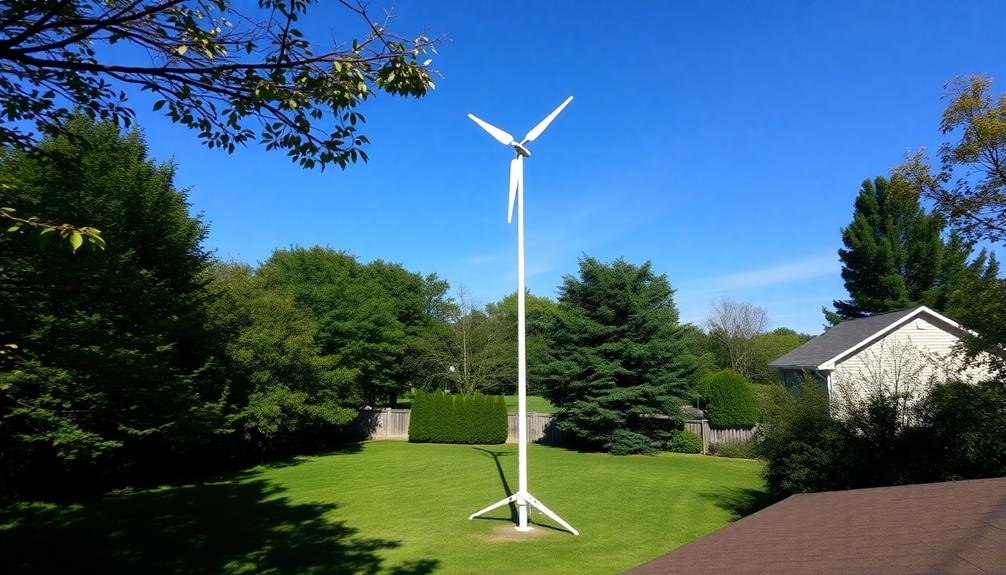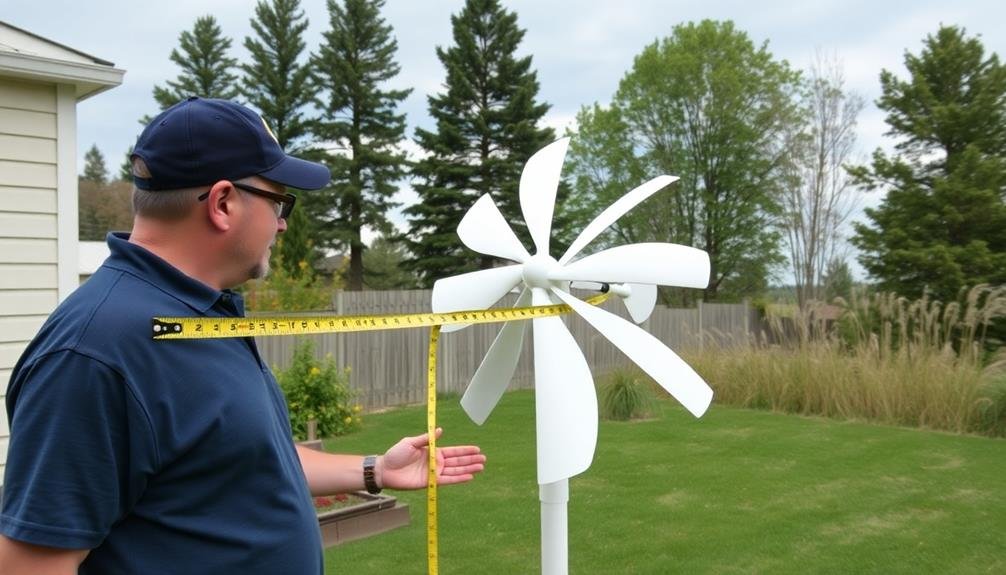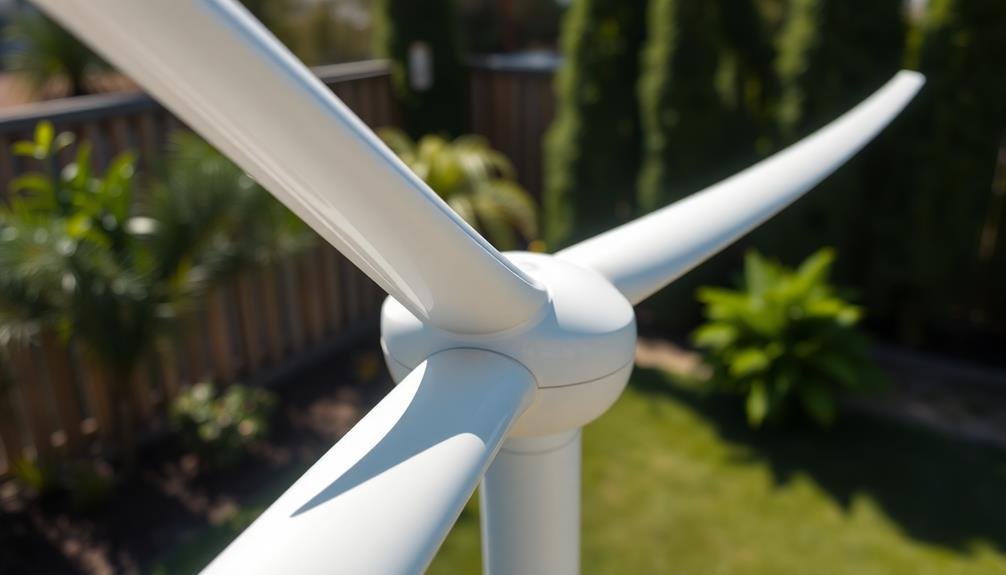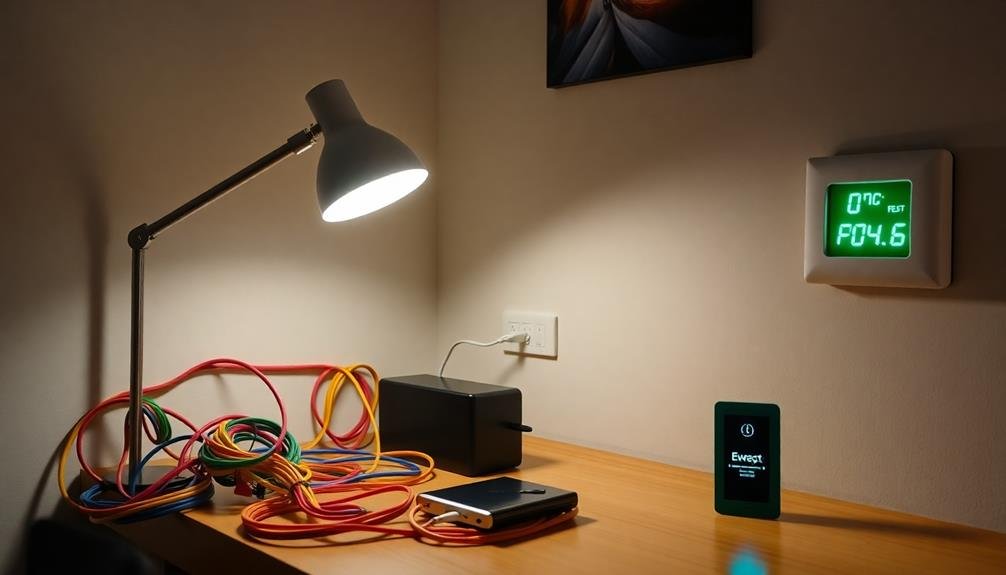Setting up a Darrieus rotor wind turbine in your backyard requires careful planning and execution. First, choose an open location with consistent wind flow. Assess wind conditions using an anemometer to determine the best turbine size for your needs. Select lightweight, durable materials for the rotor blades and design them for maximum efficiency. Install proper electrical components, including a generator and charge controller. Implement safety measures like an emergency shut-off switch and wear protective gear during installation. Maintain your turbine regularly by cleaning blades and lubricating moving parts. Connect the system to your home's power grid for ideal energy utilization. These tips will help you harness wind power effectively, but there's more to explore for a successful setup.
Choose the Right Location

Location is key when setting up your backyard Darrieus rotor wind turbine. You'll want to find an open area with consistent wind flow, free from obstructions like buildings, trees, or other structures. Ideally, place your turbine at least 30 feet away from any obstacles and on the highest point of your property.
Reflect on the wind patterns in your area. Research local wind data or use an anemometer to measure wind speeds and directions. Look for spots with average wind speeds of at least 9 mph for peak performance.
Remember, wind speeds increase with height, so taller installations generally yield better results.
Check local zoning laws and regulations before installation. Some areas have restrictions on turbine height or placement. You'll also need to take into account noise levels and potential shadow flicker, which might affect neighbors.
Ensure the ground is stable enough to support the turbine's weight and withstand strong winds. Rocky or sandy soil may require additional foundation work.
Assess Wind Conditions
To assess wind conditions for your Darrieus rotor wind turbine, you'll need to measure the average wind speed at your chosen location.
You should also identify the prevailing wind direction to optimize your turbine's positioning.
Don't forget to evaluate local wind patterns, as they can be influenced by nearby structures, trees, or topographical features.
Measure Average Wind Speed
Accurate wind speed measurement is essential for evaluating your site's potential for a Darrieus rotor wind turbine. To get reliable data, you'll need to measure wind speed over an extended period, typically 3-12 months. Use an anemometer placed at the height where you plan to install your turbine. This device records wind speeds at regular intervals, allowing you to calculate average speeds and identify patterns.
For a DIY approach, you can use a handheld anemometer and take regular manual readings. However, an automated data logger will provide more thorough results. Record measurements at least four times daily, including morning, afternoon, evening, and night. Pay attention to seasonal variations, as wind patterns often change throughout the year.
| Wind Speed (mph) | Suitability | Turbine Performance |
|---|---|---|
| 0-6 | Poor | Minimal output |
| 7-11 | Moderate | Occasional power |
| 12-20 | Good | Consistent output |
Once you've collected sufficient data, calculate your site's average wind speed. This information will help you determine if your location is suitable for a Darrieus rotor wind turbine and estimate potential energy production. Remember, higher average wind speeds generally translate to better turbine performance and more electricity generation.
Identify Prevailing Wind Direction
Along with wind speed, identifying the prevailing wind direction is essential for enhancing your Darrieus rotor wind turbine's performance. To determine the predominant wind direction in your backyard, you'll need to observe and collect data over time.
Start by installing a wind vane or weathervane on your property. Place it in an open area, away from buildings or trees that could obstruct airflow. Record the wind direction daily for at least a month, preferably longer, to get accurate results. You can also use online wind rose diagrams for your area, which visually represent wind direction and speed data.
Another method is to observe natural indicators like tree growth patterns, as trees often lean away from the prevailing wind direction. Flag poles, smoke from chimneys, and grass movement can also provide clues. For a more high-tech approach, consider using a portable anemometer with a built-in compass.
Once you've identified the prevailing wind direction, position your Darrieus rotor wind turbine perpendicular to it. This orientation will maximize the turbine's exposure to the wind, ensuring efficient energy production throughout the year.
Evaluate Local Wind Patterns
Many factors influence local wind patterns, making it essential to evaluate your specific wind conditions before installing a Darrieus rotor wind turbine. Start by observing your local environment for natural wind indicators like tree growth patterns or flags. These can provide valuable insights into prevailing wind directions and strengths.
You'll want to collect data over an extended period to account for seasonal variations. Contemplate using an anemometer to measure wind speeds at different times of day and throughout the year.
Pay attention to wind turbulence caused by nearby buildings, trees, or terrain features, as these can greatly impact turbine performance.
Analyze your collected data to determine average wind speeds, peak times, and any consistent patterns. Look for periods of sustained winds, as Darrieus rotors perform best in steady conditions.
Don't forget to think about potential obstacles that might block or redirect wind flow to your turbine's location.
If possible, consult local weather stations or wind maps for additional data. This information, combined with your on-site observations, will help you make informed decisions about turbine placement, height, and expected energy output.
Determine Turbine Size

Selecting the right size for your Darrieus rotor wind turbine is essential for ideal performance. Consider your energy needs, available space, and local wind conditions when determining turbine size.
A typical backyard Darrieus turbine ranges from 1 to 5 kW in capacity, with rotor heights between 3 and 10 meters.
For residential use, a 2 kW turbine with a 5-meter rotor height is often suitable. This size can generate around 300-400 kWh per month in areas with average wind speeds of 5-6 m/s. If you have higher energy demands or stronger winds, you might opt for a larger 3-5 kW turbine.
Don't forget to factor in your yard's dimensions. Ascertain you have enough space for the turbine's height and blade sweep, plus any required setbacks from property lines.
Also, consider local zoning regulations that may limit turbine size.
Select Appropriate Materials
Three key materials are vital for constructing a Darrieus rotor wind turbine: the blades, the tower, and the generator. For the blades, you'll need lightweight yet durable materials like fiberglass, carbon fiber, or aluminum. These materials offer the best balance between strength and weight, essential for peak performance.
The tower must be sturdy enough to support the turbine's weight and withstand strong winds. Steel or reinforced concrete are popular choices, but aluminum can also work for smaller setups. Verify the tower's height is appropriate for your location and local regulations.
For the generator, you'll need a permanent magnet alternator designed for wind turbines. Choose one that matches your power requirements and turbine size.
Here's a quick reference guide for material selection:
| Component | Material Options | Pros | Cons |
|---|---|---|---|
| Blades | Fiberglass | Lightweight, durable | Expensive |
| Carbon fiber | Very strong, light | Very expensive | |
| Aluminum | Affordable, easy to work with | Heavier | |
| Tower | Steel | Strong, reliable | Heavy, may rust |
| Reinforced concrete | Very stable | Permanent installation | |
| Generator | Permanent magnet alternator | Efficient, low maintenance | Can be costly |
Remember to factor in your budget, local availability, and technical skills when selecting materials for your Darrieus rotor wind turbine.
Design Efficient Rotor Blades

To design efficient rotor blades for your Darrieus wind turbine, you'll need to focus on three key aspects.
First, choose the best blade shape, typically a curved airfoil design that maximizes lift and minimizes drag.
Next, calculate the ideal blade length based on your desired power output and local wind conditions.
Choose Optimal Blade Shape
Designing efficient rotor blades is essential for maximizing your Darrieus wind turbine's performance. When choosing the ideal blade shape, you'll need to take into account several factors that affect efficiency and durability.
The most common blade shapes for Darrieus rotors are straight, curved, and helical. Each has its advantages:
| Shape | Efficiency | Self-starting | Noise |
|---|---|---|---|
| Straight | Moderate | Poor | Low |
| Curved | High | Moderate | Low |
| Helical | High | Good | Low |
Curved blades, like the troposkien shape, offer a good balance of efficiency and structural integrity. They're less prone to bending stress and can withstand higher wind speeds. Helical blades provide smoother operation and better self-starting capabilities but are more complex to manufacture.
Take into account your local wind conditions and fabrication skills when selecting a blade shape. For most backyard setups, curved blades are a solid choice. They're easier to build than helical blades and more efficient than straight ones. Aim for a blade length that's about 2/3 of your rotor's height for ideal performance. Remember to balance your blades carefully to reduce vibration and increase overall efficiency.
Calculate Ideal Blade Length
Calculating the ideal blade length is a crucial step in designing efficient rotor blades for your Darrieus wind turbine. To determine the best length, you'll need to take into account several factors, including the turbine's rotor diameter, aspect ratio, and expected wind speeds.
Start by measuring the rotor diameter, which is the distance between the two furthest points of the turbine's rotation. A typical aspect ratio for Darrieus turbines ranges from 2:1 to 3:1, meaning the blade length should be 2 to 3 times the rotor radius. For example, if your rotor diameter is 2 meters, the blade length could be between 2 and 3 meters.
Reflect on your local wind conditions when finalizing the blade length. Longer blades are more efficient in low wind speeds but may struggle in high winds. Shorter blades perform better in gusty conditions but sacrifice some efficiency in light breezes.
You'll also need to account for structural limitations. Longer blades require stronger materials and more robust support systems. Calculate the centrifugal forces and bending moments to confirm your chosen length doesn't exceed the material's strength limits.
Select Appropriate Blade Material
The selection of appropriate blade material is vital for designing efficient rotor blades. You'll want to choose a material that's lightweight, strong, and durable enough to withstand the forces exerted on the blades during operation. Common materials include fiberglass, carbon fiber, and aluminum.
Fiberglass is a popular choice due to its low cost, good strength-to-weight ratio, and ease of molding into aerodynamic shapes. It's also resistant to corrosion and fatigue.
Carbon fiber offers superior strength and stiffness but comes at a higher price point. It's ideal for high-performance turbines where weight reduction is essential.
Aluminum is another option, providing good strength and corrosion resistance, but it's heavier than composite materials.
Consider the environmental conditions your turbine will face. If you're in a coastal area, choose materials resistant to salt corrosion. For areas with extreme temperatures, select materials that maintain their properties across a wide temperature range.
Don't forget about maintenance; some materials may require more frequent inspections or treatments to maintain their performance over time.
Ultimately, your choice should balance performance, cost, and longevity to guarantee your Darrieus rotor operates efficiently for years to come.
Build a Sturdy Foundation
Stability forms the cornerstone of any successful wind turbine installation. For your Darrieus rotor wind turbine, you'll need to build a foundation that can withstand the forces exerted by wind and the turbine's rotation.
Start by selecting a location in your backyard that's free from obstacles and receives consistent wind.
Dig a hole at least 3 feet deep and 2 feet in diameter. Use a post-hole digger for precision. Fill the bottom with 6 inches of gravel for drainage. Next, create a concrete footing by mixing and pouring concrete into the hole. Insert a J-bolt or anchor bolt into the wet concrete, guaranteeing it protrudes enough to attach your turbine's base plate.
Allow the concrete to cure for at least 48 hours. Once set, attach the base plate to the anchor bolt using nuts and washers. Confirm it's level using a spirit level. Mount your turbine's main shaft to the base plate, making sure it's perfectly vertical.
For added stability, consider guy wires. Attach them from the top of the turbine to ground anchors set in concrete at a 45-degree angle from the base. This will help your turbine withstand strong winds and maintain its vertical position.
Install Proper Electrical Components

Wiring your Darrieus rotor wind turbine correctly is vital for safe and efficient operation. Begin by selecting a high-quality generator that matches your turbine's specifications. You'll need to connect the generator to a charge controller, which regulates the voltage and current flowing to your batteries. Choose a controller rated for your system's voltage and amperage.
Install weatherproof junction boxes to protect electrical connections from the elements. Use marine-grade wiring and connectors to withstand outdoor conditions. Don't forget to implement proper grounding to protect against lightning strikes and static buildup.
Here's a quick reference guide for essential electrical components:
| Component | Purpose | Considerations |
|---|---|---|
| Generator | Converts mechanical energy to electrical | Match turbine specs |
| Charge Controller | Regulates voltage and current | Proper voltage/amp rating |
| Batteries | Store excess energy | Deep cycle, proper capacity |
| Inverter | Converts DC to AC power | Size based on load requirements |
| Disconnect Switch | Safety feature for maintenance | Easily accessible location |
Remember to consult local building codes and regulations before installation. If you're not confident in your electrical skills, hire a professional to verify your system is set up safely and efficiently. Regular maintenance of these components will help maximize your turbine's performance and longevity.
Implement Safety Measures
When setting up your backyard Darrieus rotor wind turbine, you must prioritize safety measures.
Start by ensuring a secure foundation for your turbine to prevent accidents caused by instability.
Install an emergency shut-off switch that's easily accessible, and always wear proper protective gear when working on or around the turbine.
Secure Turbine Foundation
After assembling your Darrieus rotor, it's crucial to secure the turbine foundation with proper safety measures.
Begin by selecting a suitable location for your turbine, verifying it's away from structures, power lines, and trees. Choose a spot with stable, level ground to minimize vibrations and potential toppling.
Dig a hole for the foundation, making it at least 3 feet deep and 2 feet wide. Pour a concrete base, embedding anchor bolts for attaching the turbine's base plate. Allow the concrete to cure fully before proceeding.
Install a grounding rod near the foundation to protect against lightning strikes.
Attach the turbine's base plate to the anchor bolts using lock washers and nuts. Verify all connections are tight and secure.
Install guy wires if your turbine design requires them, anchoring them securely to the ground at a 45-degree angle from the tower.
Regularly inspect the foundation for signs of erosion, cracking, or shifting. Address any issues promptly to maintain stability.
Consider adding a protective barrier around the base to prevent accidental contact with moving parts.
Install Emergency Shut-Off Switch
With your turbine securely anchored, it's time to focus on operational safety. Installing an emergency shut-off switch is essential for your Darrieus rotor wind turbine. This switch will allow you to quickly stop the turbine in case of emergencies or during maintenance.
Choose a weatherproof switch designed for outdoor use and rated for your turbine's voltage. Mount it in an easily accessible location, preferably near the base of the turbine or on a nearby wall. Wire the switch into your turbine's main power circuit, guaranteeing it can cut off electricity flow when activated.
Test the emergency shut-off switch regularly to confirm it's functioning correctly. Train all household members on its location and proper use. Remember, safety should always be your top priority when operating a home wind turbine.
- Fear of accidents diminished
- Peace of mind during storms
- Confidence in quick response
- Relief from potential hazards
In addition to the emergency shut-off switch, consider installing other safety features like automatic braking systems and lightning protection. These measures will further enhance your turbine's safety and longevity.
Always consult local regulations and guidelines when setting up your backyard wind turbine to guarantee compliance and peak performance.
Use Proper Protective Gear
Safety gear is your first line of defense when working with a Darrieus rotor wind turbine. Always wear a hard hat to protect against falling objects and potential impacts from the turbine's moving parts.
Don't forget safety glasses or goggles to shield your eyes from debris, dust, and small particles that may become airborne during installation or maintenance.
Sturdy work gloves are essential to protect your hands from cuts, abrasions, and pinch points. Opt for gloves with good grip to guarantee you maintain control of tools and equipment.
Wear steel-toed boots to safeguard your feet from heavy objects and provide stability on uneven terrain.
If you're working at heights, use a fall protection harness and make certain it's properly secured. For electrical work, use insulated tools and wear rubber-soled shoes.
When operating power tools or during noisy conditions, use ear protection to prevent hearing damage.
Consider wearing a high-visibility vest, especially if you're working with others or in low-light conditions.
Finally, keep a first-aid kit nearby in case of minor injuries.
Optimize Performance Through Maintenance

Regular maintenance is essential for maximizing your Darrieus rotor wind turbine's performance and longevity. You'll need to inspect your turbine regularly, checking for any signs of wear, damage, or loose components.
Pay close attention to the blades, ensuring they're free from cracks, chips, or deformation. Clean the blades periodically to remove dirt, dust, and debris that can affect aerodynamics and efficiency.
Don't forget to lubricate moving parts, such as bearings and the generator shaft, according to the manufacturer's recommendations. This will reduce friction and prevent premature wear.
Check and tighten all bolts and fasteners, as vibrations can cause them to loosen over time. Monitor your turbine's output regularly to identify any sudden drops in performance, which may indicate a problem.
To keep your Darrieus rotor wind turbine in prime shape:
- Conduct monthly visual inspections to catch issues early
- Clean blades quarterly for ideal airflow and efficiency
- Lubricate bearings annually to extend their lifespan
- Schedule professional maintenance every two years for peace of mind
Connect to Home Power System
Once your Darrieus rotor wind turbine is up and running, you'll need to connect it to your home's power system. Start by installing an inverter to convert the DC power generated by the turbine into AC power compatible with your home's electrical system. Choose an inverter that matches your turbine's voltage output and your power needs.
Next, install a charge controller to regulate the power flow and protect your batteries from overcharging. Connect the turbine to the charge controller, then to a battery bank for energy storage. Use deep-cycle batteries designed for renewable energy systems.
Install a transfer switch to safely connect your wind power system to your home's electrical panel. This switch prevents backfeeding into the grid during power outages. Connect the inverter to the transfer switch, then to your main electrical panel.
For grid-tied systems, you'll need a grid-tie inverter and permission from your utility company. They may require additional safety equipment and inspections.
Consider hiring a licensed electrician to guarantee proper installation and compliance with local codes.
Frequently Asked Questions
How Loud Is a Darrieus Rotor Wind Turbine During Operation?
You'll find a Darrieus rotor wind turbine relatively quiet during operation. It's typically less noisy than horizontal-axis turbines. You might hear a gentle swooshing sound, but it's often masked by ambient noise in your surroundings.
Can a Darrieus Turbine Be Painted or Customized for Aesthetic Purposes?
Yes, you can paint and customize your Darrieus turbine for aesthetic purposes. You'll want to use weather-resistant paint and avoid adding weight or altering the blade shape. Consider colors that blend with your surroundings or express your style.
What Is the Average Lifespan of a Backyard Darrieus Wind Turbine?
You can expect your backyard Darrieus wind turbine to last 15-20 years with proper maintenance. However, its lifespan depends on factors like material quality, weather conditions, and how well you care for it. Regular inspections will help maximize longevity.
Are There Any Specific Zoning Laws or Permits Required for Installation?
You'll likely need permits for your wind turbine. Check local zoning laws, as they vary by location. Many areas require building permits, electrical inspections, and height clearances. Don't forget to take into account noise regulations and neighbor concerns.
How Does a Darrieus Turbine Perform in Turbulent or Gusty Wind Conditions?
You'll find that Darrieus turbines don't perform well in turbulent or gusty winds. They're less efficient in these conditions, as they can't adjust quickly to changing wind directions. You'll get better performance in steady, consistent winds.
In Summary
You've now got the essential tips for setting up your backyard Darrieus rotor wind turbine. Remember, success depends on careful planning, proper installation, and ongoing maintenance. Don't forget to check local regulations and consult experts if needed. With your new turbine in place, you'll be harnessing clean, renewable energy right at home. Keep monitoring its performance and making adjustments to maximize efficiency. Enjoy your sustainable energy journey!





Leave a Reply